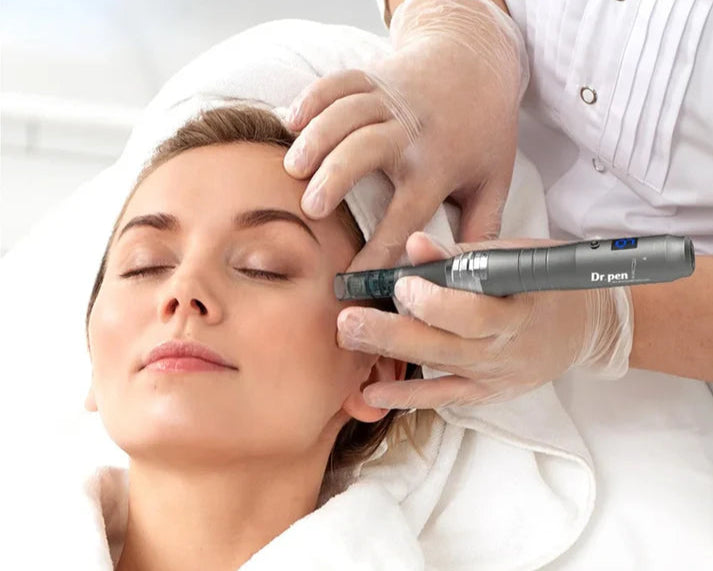In the realm of skincare and beauty treatments, the quest for smoother, firmer, and more youthful-looking skin is a never-ending journey. Among the myriad of options available, microneedling has emerged as a popular and effective procedure that promises to rejuvenate the skin. Traditionally associated with facial treatments, microneedling has sparked curiosity about its applicability on other parts of the body. This raises an intriguing question: Can a microneedling pen be used on the body?

To delve into this topic, it's essential to understand what microneedling is and how it works. Microneedling, also known as collagen induction therapy, involves the use of a device equipped with fine needles to create controlled micro-injuries on the skin's surface. These tiny punctures stimulate the body's natural healing process, prompting it to produce collagen and elastin – two crucial components for maintaining skin structure and elasticity.
The microneedling pen is a handheld device that has revolutionized this treatment. It allows for precise control over the depth and pattern of needle penetration, making it suitable for various skin concerns such as fine lines, wrinkles, scars, pigmentation, and even stretch marks. The pens are designed to be user-friendly, enabling professionals and, in some cases, individuals to perform treatments at home or in clinics.
When it comes to using a microneedling pen on the body, the principle remains the same as with the face: to induce controlled trauma to stimulate collagen production. However, the body's skin differs from facial skin in thickness, sensitivity, and the presence of hair follicles. These factors necessitate a nuanced approach when considering microneedling for areas other than the face.
One of the primary concerns when using a microneedling pen on the body is the risk of infection. The skin on the body, particularly in areas like the back, chest, and legs, may have more sebum and bacteria compared to the face. This increases the importance of thorough cleansing and sterilization before and after the procedure. Professionals must adhere to strict hygiene protocols to minimize the risk of complications.
Another consideration is the depth of needle penetration. The skin on different parts of the body varies in thickness. For instance, the skin on the arms and legs is generally thicker than that on the face. Therefore, adjusting the needle length on the microneedling pen is crucial to ensure effective treatment without causing unnecessary trauma. Using a depth that is too shallow may not yield the desired results, while going too deep can lead to pain, bleeding, and potential scarring.
The sensitivity of the skin is also a factor to consider. Areas such as the neck, décolletage, and underarms are more delicate and may require a gentler approach. It's important to start with a lower needle depth and gradually increase it based on the skin's response. Additionally, some areas of the body, like the breasts and groin, should be avoided due to the higher risk of complications.
Microneedling on the body can address several concerns. For instance, it can help improve the appearance of stretch marks by stimulating collagen production in the affected areas. It can also be effective in reducing the visibility of scars, whether from acne, surgery, or injuries. Furthermore, it can enhance skin texture and tone, making it a viable option for those seeking overall skin rejuvenation.
When performed by a trained professional, microneedling on the body can be a safe and effective treatment. However, it's crucial to choose a practitioner who has experience with body microneedling and understands the unique challenges it presents. A consultation is essential to assess the skin's condition, discuss expectations, and determine the most appropriate treatment plan.
At-home microneedling devices have gained popularity in recent years, but they come with their own set of risks. While some devices are marketed as safe for home use, the lack of professional oversight can lead to improper technique, incorrect needle depth, and potential complications. It's advisable to leave body microneedling to the experts, especially when treating larger areas or addressing specific concerns like scars and stretch marks.
In addition to the procedure itself, post-treatment care is vital for optimal results. The skin may be red, swollen, and sensitive immediately after microneedling. Applying a soothing moisturizer and avoiding sun exposure are crucial steps in the healing process. It's also important to follow any specific instructions provided by the practitioner to ensure proper recovery.
While microneedling can be a game-changer for improving the skin's appearance, it's not a magic solution. Results may take several weeks to become noticeable, and multiple sessions may be required to achieve the desired outcome. Patience and consistency are key when undergoing microneedling treatments, whether on the face or the body.
Moreover, microneedling should not be viewed as a standalone treatment. It can be combined with other skincare therapies, such as chemical peels, topical treatments, and laser therapies, to enhance its effectiveness. A personalized approach that takes into account individual skin concerns, goals, and lifestyle factors is essential for achieving the best possible results.
In conclusion, a microneedling pen can indeed be used on the body, but it requires a careful and tailored approach. Understanding the differences in skin thickness, sensitivity, and potential risks is crucial for safe and effective treatment. When performed by a skilled professional, microneedling can address a range of skin concerns on the body, from stretch marks and scars to overall skin rejuvenation. As with any skincare procedure, it's important to do thorough research, choose a reputable practitioner, and follow post-treatment care instructions to maximize the benefits and minimize the risks. Microneedling, when done correctly, can be a valuable addition to your skincare regimen, helping you achieve smoother, firmer, and more radiant skin from head to toe.

Share:
How to Extend the Life of Your Microneedling Pen
The History of Microneedling Pen in Skincare